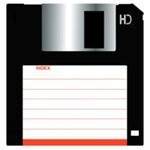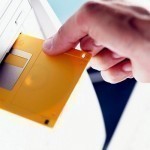Defragmenting a hard drive rearranges the files so that each file is stored in a contiguous collection of disk sectors. This makes reading and writing files much faster. Over time, Microsoft Windows will slowly fragment your files, storing parts of each file in seemingly random physical locations on the hard drive. As this happens, your files will take longer and longer to access. The solution is to defrag your hard drive. Before you Begin Before opening up the Disk Defragmenter, close programs that are running such as virus scanners. The Read More
Floppy Disk

A floppy disk is a non-volatile, magnetic storage device that can be read and written to by a floppy disk drive. Floppy disks were once the most infamous form of storage and were used to store a wide variety of files, including executable files, text files, and small audio clips. Before the advent of the personal hard drive, programs were separated into dozens of small files and stored on floppy disks, which would then have to be inserted one after another into a computer in order for a program to Read More
What Are IDE Hard Drives?
The IDE Interface Integrated Drive Electronics or (IDE) are a type of hard drive controller which bundles the components of the hard drive and its controller into one interface. This allows for much simpler installation of the hard drive into the system by removing the difficulties associated with the separation of the components and controllers such as the predecessor drives. This advancement has lead to several hard drive options which are both very large and very fast. Taking advantage of these types of hard drives can be done in nearly any computer system Read More
Maxtor Jumper Settings
An Integrated Drive Electronics (IDE) drive is a device that meets the Parallel AT Attachment, ATA or AT Attachment Packet Interface, and ATAPI standards. IDE drives include hard drives, floppy drives, and CD/DVD players. IDE drives have a specific type of cable that allows multiple streams of data to be shared between the device and computer simultaneously. IDE drives also use a specific power cable and have a unique control feature called Maxtor jumpers. Maxtor jumpers allow the user to specify what role the drive plays regarding the computer and Read More
How to Format a Hard Drive
Formatting a hard drive often becomes necessary when Trojans or viruses that are difficult to remove infect it or when there are bad sectors on it. A hard drive should be divided into small partitions to utilize the space effectively. A hard drive can also be formatted in order to reorganize the space available. Remember, formatting the hard drive or any of its partitions will completely erase all data. This article gives the steps to correctly go about the formatting exercise. Reformatting a Hard Drive with the Windows Installation Disk Read More
How to Mount an ISO
An ISO file is an image that contains all the data files and file system metadata (i.e. boot code, structures, and attributes) of a CD/DVD. In order to mount an ISO image, a disk image emulator that will allow the content of a CD/DVD to be read from an ISO image via a virtual drive is needed. Depending on the Operating System being used, the user can open built-in disk image emulators or download and install free software from the Internet. How to Mount an ISO Image under Microsoft Windows Read More
How to Format a Floppy Disk
A floppy disk is a media storage device that has been used in computers since the mid-1970s. Modern floppy disks measure 3 ½ inches diagonally and are both read and written to by a Floppy Disk Drive (FDD). While floppy disks are rarely used by modern computers and have had little to no motherboard support as of 2010, they are still used for some applications and can be accessed via external USB devices. How To Format A Floppy Disk In order to format a floppy disk, or erase its Read More
Disk Imaging
Disk imaging refers to copying the contents of a data storage device or medium, and transferring this to another, similar medium or device. In its original context, disk imaging implies the creation of an exact duplicate of a computer's hard disk drive – including its programs, setup and data then storing this in a special, compressed file format. Disk imaging aims to provide the user with an exact replica of a computer's systems and data – needed in case of a catastrophic disk crash where the user needs to recover Read More
Hard Drive
A hard drive, also known hard disk or hard disk drive, is a non-volatile data storage device. Technically, hard drives and hard disks are not the same since hard drives consist of multiple hard platters, the hard disk reader and writer head, the hard drive motor, and the drive electronics. On the other hand, a hard disk is the storage medium itself. The hard drive was invented in mid-20th century. Its earliest versions were mainly used in computers and could only store around five megabytes of data. Now, hard drives Read More
Why my Floppy Drive is being Accessed?

Most of us are using Windows PCs and sometimes some of your get into a situation where your floppy drive is randomly accessed every few minutes even though it has no floppy drive inserted. This is not dangerous for a computer system but is off course annoying to almost everyone. This occurs when some program (You are running on your computer, it could be any) considers that something should be written (or backed up) on a diskette. One of the cases, there can be a document in your recent history Read More


Share on: